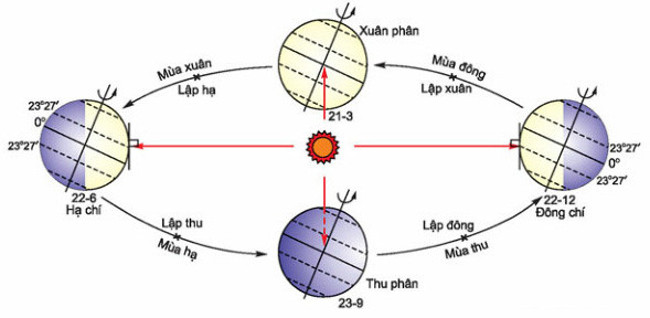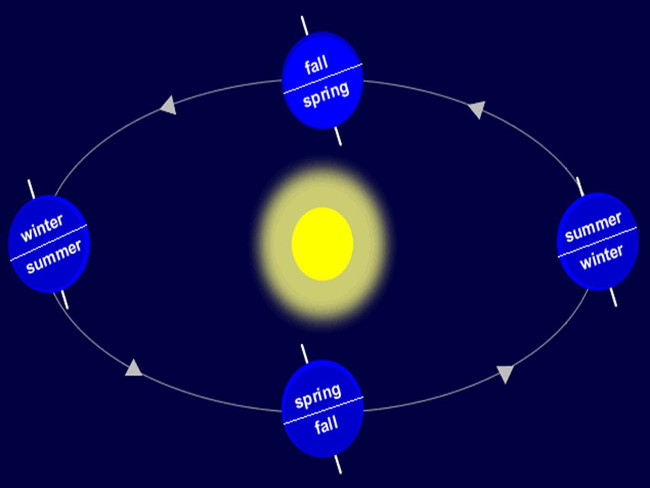What makes the seasons of the year?
Why is one year on Earth divided into four seasons: spring, summer, autumn and winter? What are the seasons that have an important impact on people's lives on Earth? Why is there a change of weather between seasons? Read the article below for answers!
According to scientists, about 4.5 billion years ago, a Mars-sized asteroid collided with the Earth. As a result, the layers of rock and dust gradually formed into the Moon. That big collision also caused the earth to tilt slightly when it moved in orbit around the Sun.
Because of that inclination, at any given time, the amount of sunlight in the Northern Hemisphere and the Southern Hemisphere will be opposite. This cycle changes with the season of the earth.
The Earth travels along an elliptical orbit around the Sun and at the same time rotates along an axis that is tilted relative to the surface of the orbit . That means different hemispheres enjoy different amounts of sunlight throughout the year. Because the Sun is our source of light and energy, the change in intensity and concentration of the sun's rays have created changes and appearances of the seasons: Winter, Spring, Summer and collection.

The seasons are marked by solstice points (once twice a year when the sun is the most equatorial to the north or south) and the Spring and Autumn points - concepts of related cosmology to the tilt of the Earth.
The solstice marks the points at which the Arctic or Antarctic has been tilted to the maximum towards or away from the Sun. That was the time when the difference between the daytime hours and the night hours was most pronounced. Releases appear each year on June 20 or 21 (Summer solstice) or December 21 or 22 (East solstice) and specify the official start of summer and winter. Spring and Fall points mark the beginning of spring and autumn.
In the Northern hemisphere , the seasons start and end the seasons of the solar calendar countries and some of the countries that use the negative - solar calendar in Asia are not the same. The countries that follow the calendar in the Northern hemisphere take four days: Spring equinox (March 21), Lower solstice (June 22), Thu Phan (September 23) and East solstice (December 22) are the first four days of four Seasons.
In the Southern hemisphere , four seasons are opposite to the Northern hemisphere. It means that on March 21 every year, the Northern Hemisphere touches gradually to the point of Xuan Phu and enjoys the signs of spring; At that time, the winds brought the cold to the Southern hemisphere because they reached the Falling point. Another segment of the year appeared on September 23, when the summer faded in the North, the cold of winter began to give way to the spring in the South.
Particularly our country and some Asian countries are used to the negative - solar calendar, the start of the seasons is calculated earlier than about 45 days.

The Earth orbit around the Sun is an elipse.(Photo: Internet source)
Especially, each season of the year is not equal to the number of days a year divided by 4 . Spring starts from the Spring day (January 23) to the Summer solstice (June 21), which is about 92 days 19 hours. The summer season starts from lower lice to autumn fall (September 23), about 93 days and 15 hours long. Fall lasts from Autumn and Winter to Winter solstice (December 22), about 89 days 19 hours long. Winter from winter solstice to spring equinox is only 89 days long. So the summer is longer than the winter of 4 days and 15 hours.
This short-term problem relates to the distance between the Earth and the Sun at each time far or near. In the summer, when the Earth is the farthest from the Sun, the Sun's attraction to it is the weakest, so the Earth's slowest rotation and the longest summer time in a year. Conversely, in the winter, when the Earth is closest to the Sun, the sun's gravity acts on it most strongly, so the Earth spins quickly and it is the shortest season of the year. In spring and autumn, there are two intermediate seasons.
Another characteristic that affects the formation of the four seasons is that the orbits of the Earth orbiting the Sun are not circular, but the shape of an ellipse, leading to the distance from the Earth to the Sun which is far and near (if rotated according to the circular orbit, the new distance is equal. This results in different amounts of heat received from the Sun and a different temperature and temperature depending on the season.
 Millions of red 'dyed' crabs on the island of Australia
Millions of red 'dyed' crabs on the island of Australia What happens when two storms clash?
What happens when two storms clash? 'Immune to poison' These 7 predators eat poisonous snake meat as easily as ... 'eat candy'
'Immune to poison' These 7 predators eat poisonous snake meat as easily as ... 'eat candy' This is the most frightening 'monster' in Earth's history, the tyrant dinosaurs have become their meals
This is the most frightening 'monster' in Earth's history, the tyrant dinosaurs have become their meals Strange story: Tortoise attacks, doves pigeons in the blink of an eye!
Strange story: Tortoise attacks, doves pigeons in the blink of an eye! At the end of the battle of death, the poisonous tiger was swallowed by the king's snake
At the end of the battle of death, the poisonous tiger was swallowed by the king's snake